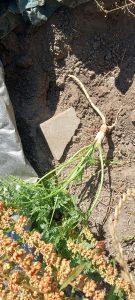The Problem:
Hemlock is a DEADLY POISONOUS plant that people can mistake for wild parsley or carrot.
All parts of this plant contain toxic alkaloids that can be fatal even in small amounts. The alkaloids can affect nerve impulse transmission to your muscles, eventually killing you through respiratory failure.
- There is no antidote for hemlock poisoning. Depending on the severity of a person's exposure, emergency treatment depends on the severity of your condition and your symptoms.
Identification/Appearance:
- Hemlock can be mistaken for a number of edible plants. The leaves bear a resemblance to parsley or carrots. It also resembles Queen Anne's Lace. The root has been mistaken for wild parsnip.
One distinctive feature is that the stem has purple blotches.
In bloom, the plant has small, white flowers.
Signs of poisoning
- Symptoms generally begin to appear 30 minutes after exposure.
- The typical symptoms for humans include dilation of the pupils, dizziness, and trembling followed by slowing of the heartbeat, paralysis of the central nervous system, muscle paralysis, and death due to respiratory failure.
- If you’re having difficulty breathing, your doctor will look for ways to secure your airway and may assist with ventilation. Your doctor will also try to decontaminate your gastrointestinal tractin order to remove the hemlock from your system.
- If you begin to experience seizures, you may be treated with antiseizure medication to lessen symptoms. You may also be treated with fluids intravenously to prevent dehydration and restore nutrient levels.
Controls
- If you do not feel safe in dealing with hemlock that is perfectly fine. Bring it to the immediate attention of either one of the members of the Operations Team, or call/text Mike Farley at 253-241-4393.
- The primary control for hemlock is to remove the entire plant -- leaves, stem and tap root. This is most effectively done by digging down into the soil to ensure you remove as much of the root as possible. Make sure to protect yourself while handling this plant: wear gloves and a long-sleeved shirt. Respiratory protection is advised.

- DO NOT DISPOSE OF HEMLOCK IN COMPOST OR PLANT RECYCLE. Plants should be put in a plastic bag, sealed properly and disposed of in garbage that will go to a landfill.
- Shovels or other tools used in removal of hemlock should be thoroughly decontaminated by washing with soap and water.
- Herbicides, such as glyphosate (e.g. Roundup) can be used prior to the plant's blooming.




